最新英语语法归纳总结及倒装句
2023年英语部分倒装用法归纳

英语部分倒装使用方法归纳1.否认副词位于句首时旳倒装在正式文体中,never.seldom.rarely.little.hardly.scarcely.n.sooner.n.longer.nowher.等具有否认意义旳副词若位于句首, 则其后要用部分倒装:.shal.neve.forgiv.him..Neve.shal..forgiv.him.我永远不会宽恕他。
H.seldo.goe.ou.fo.dinner..Seldo.doe.h.g.ou.fo.dinner.他很少出去吃饭。
Sh.hardl.ha.tim.t.liste.t.music..Hardl.doe.sh.hav.tim.t.liste.t.music.她几乎没时间听音乐。
H.littl.realize.ho.importan.thi.meetin.is..Littl.doe.h.realiz.ho.importan.t hi.meetin.is.他不甚明白这个会议旳重要性。
W.ha.n.soone.reache.th.airpor.tha.th.plan.too.off..N.soone.ha.w.reache.t h.airpor.tha.th.plan.too.off.我们刚到机场,飞机就起飞了。
【注意】(1.对于not…until句型, 当no.until…位于句首时, 其后旳主句要用倒装语序:H.didn’.leav.th.roo.unti.th.rai.stopped..No.unti.th.rai.stoppe.di.h.leav.th.room.雨停了之后他才离开这房间。
(2.某些起副词作用旳介词短语, 由于具有否认词, 若位于句首, 其后要用部分倒装:O.n.account.mus.thi.switc.b.touched.这个开关是绝不能触摸旳。
I.[Under.n.circumstance.wil..len.mone.t.him.无论怎样我也不会再借钱给他了。
英语倒装句的归纳总结
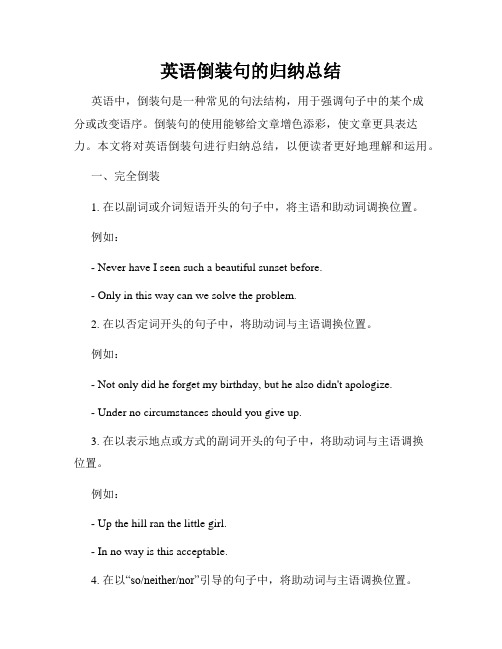
英语倒装句的归纳总结英语中,倒装句是一种常见的句法结构,用于强调句子中的某个成分或改变语序。
倒装句的使用能够给文章增色添彩,使文章更具表达力。
本文将对英语倒装句进行归纳总结,以便读者更好地理解和运用。
一、完全倒装1. 在以副词或介词短语开头的句子中,将主语和助动词调换位置。
例如:- Never have I seen such a beautiful sunset before.- Only in this way can we solve the problem.2. 在以否定词开头的句子中,将助动词与主语调换位置。
例如:- Not only did he forget my birthday, but he also didn't apologize.- Under no circumstances should you give up.3. 在以表示地点或方式的副词开头的句子中,将助动词与主语调换位置。
例如:- Up the hill ran the little girl.- In no way is this acceptable.4. 在以“so/neither/nor”引导的句子中,将助动词与主语调换位置。
例如:- So beautiful is the scenery that it takes my breath away.- Neither have I finished my homework, nor has my brother.二、部分倒装1. 在以“if/whether”引导的条件句中。
例如:- If you work hard, you will achieve your goals.- Whether he comes or not, we will have the party.2. 在以“so that/such that”引导的结果状语从句中。
例如:- He spoke so quickly that I couldn't catch up with him.- The problem is such that it requires a professional to solve it.3. 在以“as/though”引导的方式状语从句中。
倒装句语法知识点归纳总结

倒装句语法知识点归纳总结1. 在以no sooner, hardly, at no time, little, seldom, never, not only等否定词或者否定短语引导的句子中,主语和谓语部分需要倒装。
例如:- No sooner had I arrived at the station than the train left.- Hardly did we start our journey when the rain began to fall.2. 在表示地点或者时间的介词短语放在句首时,需要进行倒装。
例如:- On the corner stood a tall and handsome man.- Under the table lay a sleeping cat.3. 在表示方向的副词放在句首时,需要进行倒装。
例如:- Down the street came a group of excited children.- Up the hill ran the little girl.4. 在以“so+形容词/副词+助动词/情态动词+主语”结构引导的句子中,需要进行倒装。
例如:- So quickly did she finish the test that she had time to review her answers.5. 在以“such+名词+从句”结构引导的句子中,需要进行倒装。
例如:- Such was his love for her that he would do anything for her.总的来说,倒装句的使用可以增强语气,突出句中的某些部分,使句子更具有表现力和影响力。
在写作和口语表达中,适当地运用倒装句可以提高语言的表达能力和水平。
需要注意的是,在使用倒装句时,对于不同的语法规则和用法要有清晰的认识和理解,以避免出现错误的倒装句结构,从而影响句子的意思和表达效果。
英语倒装句的归纳总结

英语倒装句是一种特殊的句子结构,它指的是将谓语动词(或助动词)放在主语前面的句子。
根据倒装的程度,英语倒装句分为完全倒装和部分倒装。
下面我们详细地归纳和总结英语倒装句的类型和用法。
一、完全倒装1. 用于"there be" 句型。
例如:- There is a book on the table.(桌子上有一本书。
)- There will be a party next week.(下周将有一个聚会。
)2. 用于here, there, now, then 等不及物动词主语的句型中,或以in, out, up, down, away 等副词开头的句子里,以表示强调。
例如:- Here comes the bus.(公交车来了。
)- There goes the bell.(铃响了。
)- Now it's your turn.(现在轮到你了。
)3. 当句首状语为表示地点的介词词组时,也常将其全部倒装。
例如:- Outside the door stands a statue.(门外有一尊雕像。
)- From the top of the mountain, we can see the whole city.(从山顶上,我们可以看到整个城市。
)4. 表语置于句首时,倒装结构为"表语连系动词主语"。
例如:- Beautiful it is!(真美啊!)- Rarely has he been late.(他很少迟到。
)二、部分倒装1. 用于so that, so...that... 等句型中,将so 所修饰的形容词或副词置于句首,so 从句用倒装。
例如:- So loudly did he speak that everyone heard him.(他讲话声音如此之大,每个人都听到了。
)2. 用于疑问句中,助动词或情态动词放在主语前面。
例如:- Can you speak English?(你会说英语吗?)- Should we go there now?(我们现在去那里好吗?)3. 用于否定句中,助动词或情态动词放在主语前面。
英语倒装句12种类型及例句
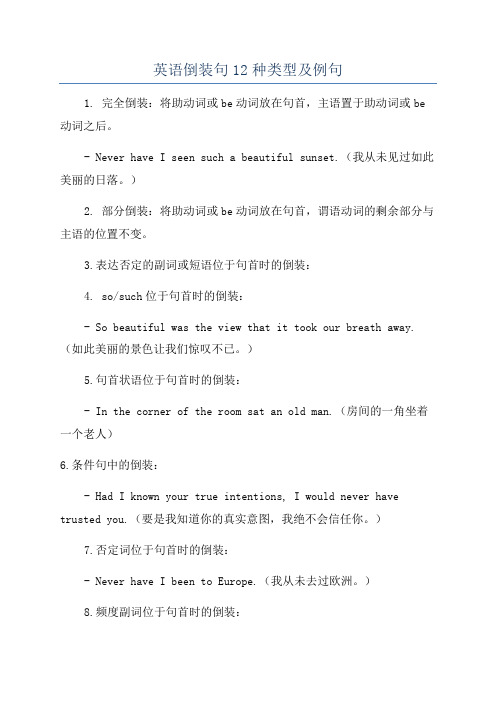
英语倒装句12种类型及例句1. 完全倒装:将助动词或be动词放在句首,主语置于助动词或be 动词之后。
- Never have I seen such a beautiful sunset.(我从未见过如此美丽的日落。
)2. 部分倒装:将助动词或be动词放在句首,谓语动词的剩余部分与主语的位置不变。
3.表达否定的副词或短语位于句首时的倒装:4. so/such位于句首时的倒装:- So beautiful was the view that it took our breath away.(如此美丽的景色让我们惊叹不已。
)5.句首状语位于句首时的倒装:- In the corner of the room sat an old man.(房间的一角坐着一个老人)6.条件句中的倒装:- Had I known your true intentions, I would never have trusted you.(要是我知道你的真实意图,我绝不会信任你。
)7.否定词位于句首时的倒装:- Never have I been to Europe.(我从未去过欧洲。
)8.频度副词位于句首时的倒装:- Rarely do we see such dedication.(我们很少见到如此的奉献精神。
)9.祈使句或祈使句部分的倒装:- Stand up!(站起来!)- Be quiet, please.(请安静。
)10. only位于句首时的倒装:- Only by working hard can you achieve your goals.(只有通过努力工作,你才能实现目标。
)11.地点状语置于句首时的倒装:- In the garden were beautiful flowers.(花园里有美丽的花朵。
)12.宾语置于句首时的倒装:- A love like this I have never felt before.(我之前从未感受过如此的爱。
英语倒装句的归纳总结顺口溜
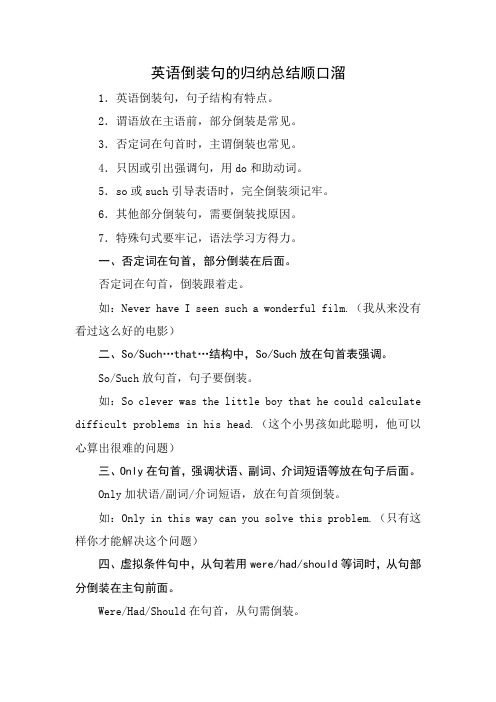
英语倒装句的归纳总结顺口溜1.英语倒装句,句子结构有特点。
2.谓语放在主语前,部分倒装是常见。
3.否定词在句首时,主谓倒装也常见。
4.只因或引出强调句,用do和助动词。
5.so或such引导表语时,完全倒装须记牢。
6.其他部分倒装句,需要倒装找原因。
7.特殊句式要牢记,语法学习方得力。
一、否定词在句首,部分倒装在后面。
否定词在句首,倒装跟着走。
如:Never have I seen such a wonderful film.(我从来没有看过这么好的电影)二、So/Such…that…结构中,So/Such放在句首表强调。
So/Such放句首,句子要倒装。
如:So clever was the little boy that he could calculate difficult problems in his head.(这个小男孩如此聪明,他可以心算出很难的问题)三、Only在句首,强调状语、副词、介词短语等放在句子后面。
Only加状语/副词/介词短语,放在句首须倒装。
如:Only in this way can you solve this problem.(只有这样你才能解决这个问题)四、虚拟条件句中,从句若用were/had/should等词时,从句部分倒装在主句前面。
Were/Had/Should在句首,从句需倒装。
如:Should it rain tomorrow,we wouldn't be able to go on the hiking trip.(如果明天下雨的话,我们就不可能去徒步旅行了)五、让步状语从句中,as/though引导的从句表强调放在句首时需要倒装。
as/though表强调,引导从句须倒装。
如:Though he is a child,he knows a lot of knowledge.(虽然他还是个孩子,但他知道很多知识)。
倒装句语法知识点归纳总结
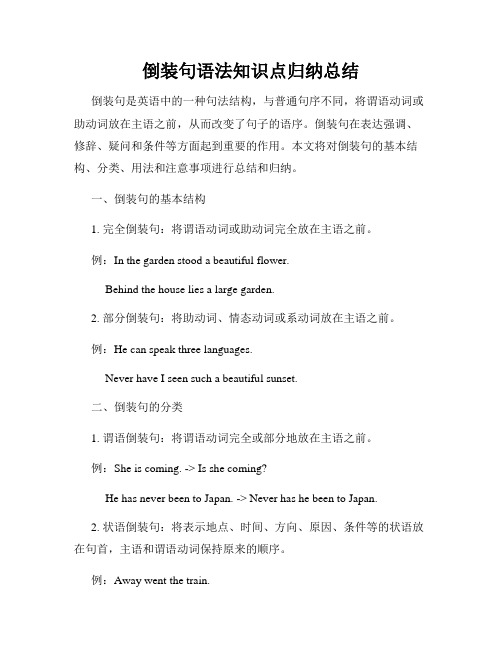
倒装句语法知识点归纳总结倒装句是英语中的一种句法结构,与普通句序不同,将谓语动词或助动词放在主语之前,从而改变了句子的语序。
倒装句在表达强调、修辞、疑问和条件等方面起到重要的作用。
本文将对倒装句的基本结构、分类、用法和注意事项进行总结和归纳。
一、倒装句的基本结构1. 完全倒装句:将谓语动词或助动词完全放在主语之前。
例:In the garden stood a beautiful flower.Behind the house lies a large garden.2. 部分倒装句:将助动词、情态动词或系动词放在主语之前。
例:He can speak three languages.Never have I seen such a beautiful sunset.二、倒装句的分类1. 谓语倒装句:将谓语动词完全或部分地放在主语之前。
例:She is coming. -> Is she coming?He has never been to Japan. -> Never has he been to Japan.2. 状语倒装句:将表示地点、时间、方向、原因、条件等的状语放在句首,主语和谓语动词保持原来的顺序。
例:Away went the train.In the distance could be seen a tall tower.3. 主从倒装句:主句和从句中的主语-谓语结构进行倒装。
例:Not until she finished her homework did she go to bed.Only when the rain stopped could we go outside.三、倒装句的用法1. 强调句:通过倒装句,可以将句子的某一部分进行强调,常用的结构是完全倒装句和部分倒装句。
例:Not only did he win the game, but he also broke the record.Under no circumstances should you touch the red button.2. 疑问句:直接将谓语动词或助动词放在主语之前形成疑问句。
倒装句的用法归纳总结
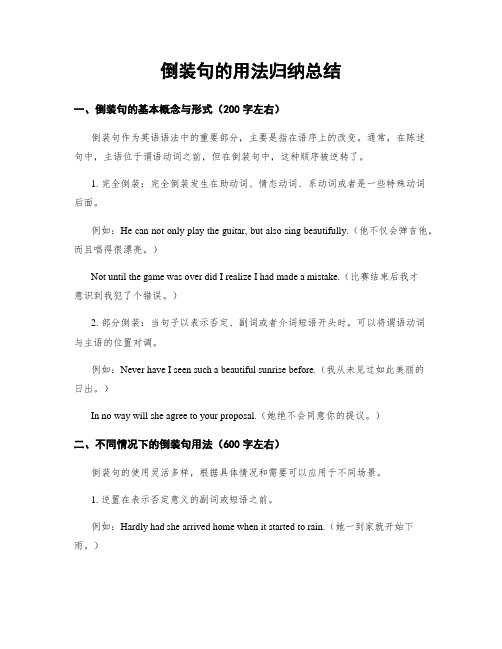
倒装句的用法归纳总结一、倒装句的基本概念与形式(200字左右)倒装句作为英语语法中的重要部分,主要是指在语序上的改变。
通常,在陈述句中,主语位于谓语动词之前,但在倒装句中,这种顺序被逆转了。
1. 完全倒装:完全倒装发生在助动词、情态动词、系动词或者是一些特殊动词后面。
例如:He can not only play the guitar, but also sing beautifully.(他不仅会弹吉他,而且唱得很漂亮。
)Not until the game was over did I realize I had made a mistake.(比赛结束后我才意识到我犯了个错误。
)2. 部分倒装:当句子以表示否定、副词或者介词短语开头时,可以将谓语动词与主语的位置对调。
例如:Never have I seen such a beautiful sunrise before.(我从未见过如此美丽的日出。
)In no way will she agree to your proposal.(她绝不会同意你的提议。
)二、不同情况下的倒装句用法(600字左右)倒装句的使用灵活多样,根据具体情况和需要可以应用于不同场景。
1. 逆置在表示否定意义的副词或短语之前。
例如:Hardly had she arrived home when it started to rain.(她一到家就开始下雨。
)Under no circumstances should you disturb the birds' nests.(在任何情况下都不应该打扰鸟巢。
)2. 用于强调句子中的某一成分。
例如:It is in the library that students can find a quiet place to study.(只有在图书馆里学生才能找到一个安静的地方学习。
)Only after years of practice can one master a musical instrument perfectly.(只有经过多年的练习,一个人才能完美地掌握一种乐器。
英语语法倒装句的知识点归纳
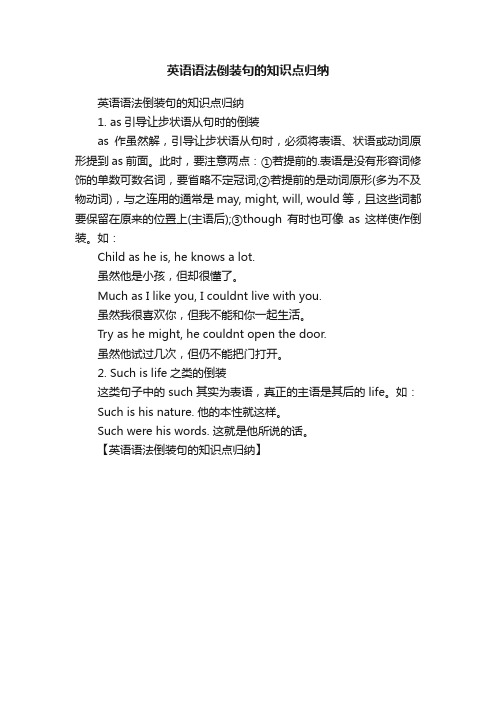
英语语法倒装句的知识点归纳
英语语法倒装句的知识点归纳
1. as引导让步状语从句时的倒装
as作虽然解,引导让步状语从句时,必须将表语、状语或动词原形提到as前面。
此时,要注意两点:①若提前的.表语是没有形容词修饰的单数可数名词,要省略不定冠词;②若提前的是动词原形(多为不及物动词),与之连用的通常是may, might, will, would等,且这些词都要保留在原来的位置上(主语后);③though有时也可像as这样使作倒装。
如:
Child as he is, he knows a lot.
虽然他是小孩,但却很懂了。
Much as I like you, I couldnt live with you.
虽然我很喜欢你,但我不能和你一起生活。
Try as he might, he couldnt open the door.
虽然他试过几次,但仍不能把门打开。
2. Such is life之类的倒装
这类句子中的 such 其实为表语,真正的主语是其后的 life。
如:Such is his nature. 他的本性就这样。
Such were his words. 这就是他所说的话。
【英语语法倒装句的知识点归纳】。
英语倒装句的用法归纳
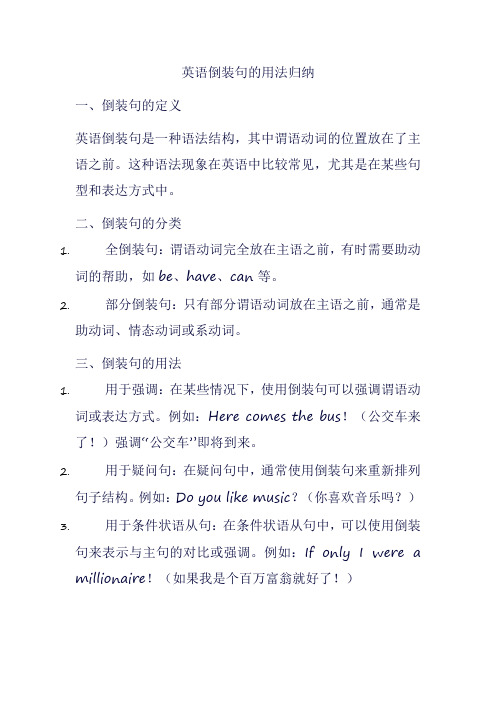
英语倒装句的用法归纳一、倒装句的定义英语倒装句是一种语法结构,其中谓语动词的位置放在了主语之前。
这种语法现象在英语中比较常见,尤其是在某些句型和表达方式中。
二、倒装句的分类1.全倒装句:谓语动词完全放在主语之前,有时需要助动词的帮助,如be、have、can等。
2.部分倒装句:只有部分谓语动词放在主语之前,通常是助动词、情态动词或系动词。
三、倒装句的用法1.用于强调:在某些情况下,使用倒装句可以强调谓语动词或表达方式。
例如:Here comes the bus!(公交车来了!)强调“公交车”即将到来。
2.用于疑问句:在疑问句中,通常使用倒装句来重新排列句子结构。
例如:Do you like music?(你喜欢音乐吗?)3.用于条件状语从句:在条件状语从句中,可以使用倒装句来表示与主句的对比或强调。
例如:If only I were a millionaire!(如果我是个百万富翁就好了!)4.用于让步状语从句:在让步状语从句中,可以使用倒装句来表示转折关系。
例如:Try to find a way to solve the problem!(试着找到解决问题的方法!)5.用于虚拟语气:在虚拟语气中,可以使用倒装句来表示与实际情况相反的情况。
例如:If I were you,I would go to the party.(如果我是你,我会去参加派对。
)6.用于某些固定句型:有些固定句型要求使用倒装句。
例如:“Hardly had she sat down when the phone rang.”(她刚坐下电话就响了。
)7.表示惊讶、感叹、讽刺等情绪时也可以使用倒装句。
例如:How could you do such a thing!(你怎么能做出这种事!)四、倒装句的用法归纳总结1.英语倒装句是一种语法结构,主要有全倒装句和部分倒装句两种类型。
2.使用倒装句可以强调谓语动词或表达方式,也可以用于疑问句、条件状语从句、让步状语从句和虚拟语气等语法结构中。
倒装句子知识点总结
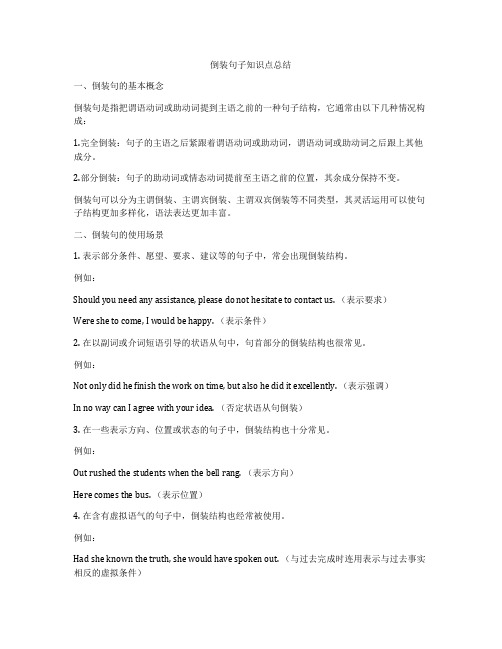
倒装句子知识点总结一、倒装句的基本概念倒装句是指把谓语动词或助动词提到主语之前的一种句子结构,它通常由以下几种情况构成:1.完全倒装:句子的主语之后紧跟着谓语动词或助动词,谓语动词或助动词之后跟上其他成分。
2.部分倒装:句子的助动词或情态动词提前至主语之前的位置,其余成分保持不变。
倒装句可以分为主谓倒装、主谓宾倒装、主谓双宾倒装等不同类型,其灵活运用可以使句子结构更加多样化,语法表达更加丰富。
二、倒装句的使用场景1. 表示部分条件、愿望、要求、建议等的句子中,常会出现倒装结构。
例如:Should you need any assistance, please do not hesitate to contact us. (表示要求)Were she to come, I would be happy. (表示条件)2. 在以副词或介词短语引导的状语从句中,句首部分的倒装结构也很常见。
例如:Not only did he finish the work on time, but also he did it excellently. (表示强调)In no way can I agree with your idea. (否定状语从句倒装)3. 在一些表示方向、位置或状态的句子中,倒装结构也十分常见。
例如:Out rushed the students when the bell rang. (表示方向)Here comes the bus. (表示位置)4. 在含有虚拟语气的句子中,倒装结构也经常被使用。
例如:Had she known the truth, she would have spoken out. (与过去完成时连用表示与过去事实相反的虚拟条件)Should I be the one chosen, I promise to work hard. (与虚拟条件连用)三、倒装句的基本结构及使用方法1. 主谓倒装在一些特殊情况下,主语和谓语的位置会倒置。
倒装语法知识点总结
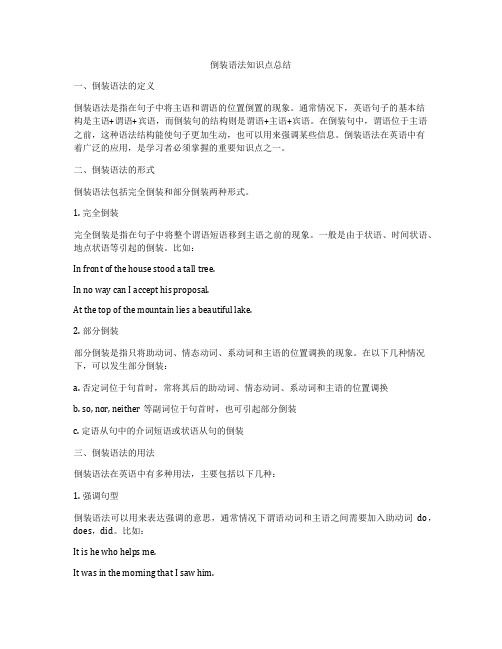
倒装语法知识点总结一、倒装语法的定义倒装语法是指在句子中将主语和谓语的位置倒置的现象。
通常情况下,英语句子的基本结构是主语+谓语+宾语,而倒装句的结构则是谓语+主语+宾语。
在倒装句中,谓语位于主语之前,这种语法结构能使句子更加生动,也可以用来强调某些信息。
倒装语法在英语中有着广泛的应用,是学习者必须掌握的重要知识点之一。
二、倒装语法的形式倒装语法包括完全倒装和部分倒装两种形式。
1. 完全倒装完全倒装是指在句子中将整个谓语短语移到主语之前的现象。
一般是由于状语、时间状语、地点状语等引起的倒装。
比如:In front of the house stood a tall tree.In no way can I accept his proposal.At the top of the mountain lies a beautiful lake.2. 部分倒装部分倒装是指只将助动词、情态动词、系动词和主语的位置调换的现象。
在以下几种情况下,可以发生部分倒装:a. 否定词位于句首时,常将其后的助动词、情态动词、系动词和主语的位置调换b. so, nor, neither等副词位于句首时,也可引起部分倒装c. 定语从句中的介词短语或状语从句的倒装三、倒装语法的用法倒装语法在英语中有多种用法,主要包括以下几种:1. 强调句型倒装语法可以用来表达强调的意思,通常情况下谓语动词和主语之间需要加入助动词do,does,did。
比如:It is he who helps me.It was in the morning that I saw him.It is from him that I heard the news.2. 省略连接词的句子当省略从句的连接词或副词时,可以用倒装语法来表示。
比如:Should you come, please let me know.If you need any help, just give me a call.Wherever she goes, there is always a crowd of people around her.3. 特殊疑问句在特殊疑问句中,如果询问的是某个特定的内容,通常要用到倒装语法。
英语倒装句的用法归纳总结
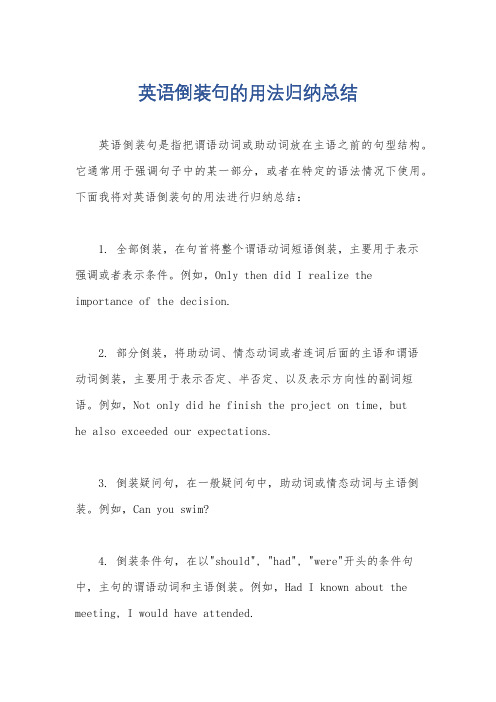
英语倒装句的用法归纳总结
英语倒装句是指把谓语动词或助动词放在主语之前的句型结构。
它通常用于强调句子中的某一部分,或者在特定的语法情况下使用。
下面我将对英语倒装句的用法进行归纳总结:
1. 全部倒装,在句首将整个谓语动词短语倒装,主要用于表示
强调或者表示条件。
例如,Only then did I realize the importance of the decision.
2. 部分倒装,将助动词、情态动词或者连词后面的主语和谓语
动词倒装,主要用于表示否定、半否定、以及表示方向性的副词短语。
例如,Not only did he finish the project on time, but
he also exceeded our expectations.
3. 倒装疑问句,在一般疑问句中,助动词或情态动词与主语倒装。
例如,Can you swim?
4. 倒装条件句,在以"should", "had", "were"开头的条件句中,主句的谓语动词和主语倒装。
例如,Had I known about the meeting, I would have attended.
5. 倒装句型用于表示方向性的副词短语,如,Here comes the bus.
总的来说,英语倒装句的使用有一定的规律,主要用于强调、
条件句、疑问句和特定的副词短语。
在写作和口语表达中,合适地
运用倒装句可以使语言更加生动有力。
希望以上总结对你有所帮助。
倒装句用法归纳整理

完全倒装&部分倒装一、完全倒装( 5items )1. 表示动作趋向的副词置于句首时且主语是名词,动词是表示运动或存现:Here/ There ;In / Out; Up/Down; Away + be/come/go/ rush/run + 主语Eg. Here comes the bus. There goes the bell.Up flew the balloon. Down fell the apples from the tree.Away went the angry manager. IncameMr. Wang.2. 时间副词 Now/ Then 置于句首,主语是名词,动词是趋向或存现动词go/come/be/rush/run 等Eg. Now comes your turn. Then starts another programme.3.地点介词作状语放在句首,主语是名词,动词表存现On top the mountain stands an old tree.At the foot of the hill lies a village.In front of the village runs a stream.4 .代词前置Such was Einstein, a great and cute man .5.表语前置(现在分词、过去分词、形容词)时实行完全倒装Walking beside me were some visitors from abroad.Gone are the days when the Chinese were looked down upon by foreigners. Attached to the meeting was a card.Present at the meeting were some leaders of the town.二、部分倒装( 10items )1. 否定词或半否定词置于句首,部分倒装Never/ Hardly/Seldom/ Little/Nowhere/ By no means … +助+主语Little does she care about what she looks.By no means will I forgive you.2. Not only+助+主谓 but also +主谓,前倒后不倒Not only had he sold out his house but he also sold his baby for drugs.3. Not until+主谓+助主谓,前不倒后倒Not until I began to work did I know how much I needed to learn.另外注意 It is not until …that…句型4. So /Neither/Nor 放在句首用部分倒装---He loves football. ---So do I.---He never swims. ----Neither/Nor does his girlfriend.5. Hardly/ No sooner had sb done when/ than sb did sth.Hardly had they arrived when it began to rain.6. So …that …/ Such …that 前倒后不倒So happy were the audiences that they laughed again and again. Such good weather is it that we feel like going outing.7. as/though 引导的让步状语从句( 4items )Child as he is, he manages to make a living by working in a factory.Strange as his idea might sound, it was a accepted at last.Hard as I tried, I couldn ’tpersuade her.Try as he might, he couldn ’t pass the exam.8. Only+状语(从句)置于句首,主句用倒装Only in this way can you improve your English.Only whenI became a mother myself did I know how tired my mother oncewas.9. 省略 if 的虚拟条件句中,将助动词 had/should/were 等提前,如果这些助动词跟有否定词 not, not 不提前If it hadn’t been for your timely help, I would still be in trouble now.= Had it not been for your timely help, I would still be in trouble now.10. 祝愿May you be happy !。
倒装句用法知识点总结

倒装句用法知识点总结倒装句是英语语法中的一种特殊句型,通过改变主谓语序,使得句子结构更加灵活且具有强调的效果。
在英语中,倒装句常见于疑问句、条件句、以及某些特定情况下。
本文将对倒装句的用法进行总结和归纳。
一、全倒装句全倒装句是指将助动词或情态动词放在主语之前,与否定词或者表示否定意义的副词连用。
全倒装句的结构如下:1. 在一般疑问句中,将助动词放在主语之前。
例如:- Do you like apples? (你喜欢苹果吗?)- Can he swim? (他会游泳吗?)2. 在以疑问代词引导的特殊疑问句中,将助动词放在主语之前。
例如:- What did you eat for breakfast? (你早餐吃了什么?)- Where can we find the nearest restroom? (我们可以在哪里找到最近的洗手间?)3. 在以否定词或表示否定意义的副词开头的句子中,将助动词放在主语之前。
例如:- Never have I seen such a beautiful sunset. (我从未见过如此美丽的日落。
)- Not only did she study hard, but she also achieved excellent results. (她不仅学习刻苦,而且取得了优异的成绩。
)二、部分倒装句部分倒装句是指将助动词、情态动词、或者动词本身的某种形式放在句首,与主语之间倒装。
部分倒装句的结构如下:1. 在以否定副词开头的句子中,将助动词或情态动词放在句首。
例如:- Rarely do I go to bed before midnight. (我很少在午夜前睡觉。
)- Seldom has he been to the countryside. (他很少去过农村。
)2. 在以表示“否定”“否认”“无法”等意义的副词开头的句子中,将情态动词、助动词或谓语动词的某种形式放在句首。
高中英语知识点归纳倒装句的用法及常见情况

高中英语知识点归纳倒装句的用法及常见情况倒装句是英语语法中一个重要的句法结构,它在句子中有特殊的应用。
本文将归纳总结高中英语中关于倒装句的用法及常见情况,以帮助大家更好地理解和运用倒装句。
一、倒装句的基本用法倒装句是指把原本主语和谓语的次序颠倒,使谓语动词或助动词出现在主语之前的一种句法结构。
在英语中,倒装句主要有三种基本形式:全部倒装、部分倒装和助动词倒装。
1. 全部倒装全部倒装是指将整个谓语部分完全颠倒,即将谓语动词或助动词放在主语之前。
常见情况有:在以否定词开头的句子中,当否定副词not,never,hardly,scarcely,little等放在句首时;以及在表示地点、时间或方式的状语从句中。
例1:Not only does he speak English fluently, but he also speaks French.例2:Hardly had I arrived home when it started to rain.例3:In the garden were some beautiful flowers.2. 部分倒装部分倒装是指将助动词,或情态动词,或谓语动词的某些形式移到主语之前。
常见情况包括:带有否定意义的词或短语出现在句首时;含有表示条件的副词或介词短语的句子;以及为了强调某一部分内容。
例4:Never have I seen such a beautiful sunset.例5:Had I known the truth, I would not have told her.例6:Only in this way can we achieve success in our study.3. 助动词倒装助动词倒装是指将助动词提到主语之前,用于疑问句或以so/neither/nor开头的句子,其目的是避免重复。
例7:Do you know him? —— No, I don't.例8:She is reading a book, and so am I.例9:He doesn't like ice cream, and neither do I.二、倒装句的常见情况除了基本的倒装句形式外,倒装句还有一些常见的情况和特殊用法需要掌握。
英语语法归纳总结及倒装句(附答案)
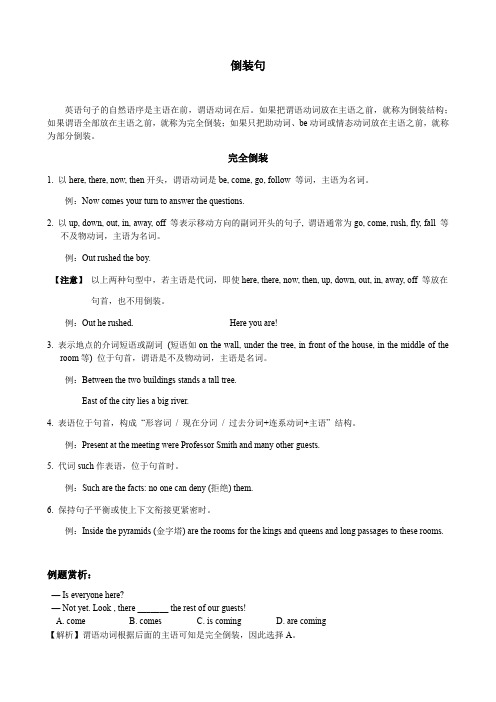
倒装句英语句子的自然语序是主语在前,谓语动词在后。
如果把谓语动词放在主语之前,就称为倒装结构;如果谓语全部放在主语之前,就称为完全倒装;如果只把助动词、be动词或情态动词放在主语之前,就称为部分倒装。
完全倒装1. 以here, there, now, then开头,谓语动词是be, come, go, follow 等词,主语为名词。
例:Now comes your turn to answer the questions.2. 以up, down, out, in, away, off 等表示移动方向的副词开头的句子, 谓语通常为go, come, rush, fly, fall 等不及物动词,主语为名词。
例:Out rushed the boy.【注意】以上两种句型中,若主语是代词,即使here, there, now, then, up, down, out, in, away, off 等放在句首,也不用倒装。
例:Out he rushed. Here you are!3. 表示地点的介词短语或副词(短语如on the wall, under the tree, in front of the house, in the middle of theroom等) 位于句首,谓语是不及物动词,主语是名词。
例:Between the two buildings stands a tall tree.East of the city lies a big river.4. 表语位于句首,构成“形容词/ 现在分词/ 过去分词+连系动词+主语” 结构。
例:Present at the meeting were Professor Smith and many other guests.5. 代词such作表语,位于句首时。
例:Such are the facts: no one can deny (拒绝) them.6. 保持句子平衡或使上下文衔接更紧密时。
倒装句型知识点总结
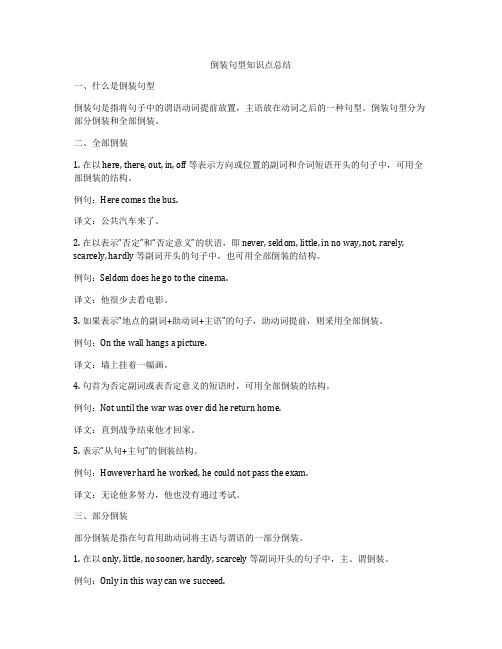
倒装句型知识点总结一、什么是倒装句型倒装句是指将句子中的谓语动词提前放置,主语放在动词之后的一种句型。
倒装句型分为部分倒装和全部倒装。
二、全部倒装1. 在以 here, there, out, in, off 等表示方向或位置的副词和介词短语开头的句子中,可用全部倒装的结构。
例句:Here comes the bus.译文:公共汽车来了。
2. 在以表示“否定”和“否定意义”的状语,即 never, seldom, little, in no way, not, rarely, scarcely, hardly 等副词开头的句子中,也可用全部倒装的结构。
例句:Seldom does he go to the cinema.译文:他很少去看电影。
3. 如果表示“地点的副词+助动词+主语”的句子,助动词提前,则采用全部倒装。
例句:On the wall hangs a picture.译文:墙上挂着一幅画。
4. 句首为否定副词或表否定意义的短语时,可用全部倒装的结构。
例句:Not until the war was over did he return home.译文:直到战争结束他才回家。
5. 表示“从句+主句”的倒装结构。
例句:However hard he worked, he could not pass the exam.译文:无论他多努力,他也没有通过考试。
三、部分倒装部分倒装是指在句首用助动词将主语与谓语的一部分倒装。
1. 在以 only, little, no sooner, hardly, scarcely 等副词开头的句子中,主、谓倒装。
例句:Only in this way can we succeed.译文:只有这样,我们才能成功。
2. 在以表示“基本上否定意义的频度词、程度副词或时间状语”如 seldom, never, not, hardly, nowhere, little, no more, at no time, by no means, in no way, in no circumstances, on no occasion, in no sense, under no conditions, under no circumstances, barely, seldom, little, rarely 等开头的句子中,主、谓倒装。
英语语法 “倒装句”超级大汇总
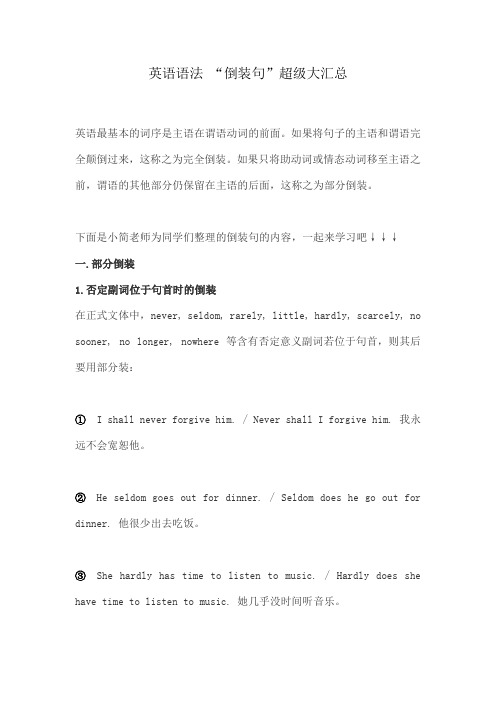
英语语法“倒装句”超级大汇总英语最基本的词序是主语在谓语动词的前面。
如果将句子的主语和谓语完全颠倒过来,这称之为完全倒装。
如果只将助动词或情态动词移至主语之前,谓语的其他部分仍保留在主语的后面,这称之为部分倒装。
下面是小简老师为同学们整理的倒装句的内容,一起来学习吧↓↓↓一.部分倒装1.否定副词位于句首时的倒装在正式文体中,never, seldom, rarely, little, hardly, scarcely, no sooner, no longer, nowhere 等含有否定意义副词若位于句首,则其后要用部分装:①I shall never forgive him. / Never shall I forgive him. 我永远不会宽恕他。
②He seldom goes out for dinner. / Seldom does he go out for dinner. 他很少出去吃饭。
③She hardly has time to listen to music. / Hardly does she have time to listen to music. 她几乎没时间听音乐。
④He little realizes how important this meeting is. / Little does he realize how important this meeting is. 他不甚明白这个会议的重要性。
⑤We had no sooner reached the airport than the plane took off. / No sooner had we reached the airport than the plane took off. 我们刚到机场,飞机就起飞了。
注意(1) 对于not…until句型,当not until…位于句首时,其后的主句要用倒装语序:He didn’t leave the room until the rain stopped. / Not until the rain stopped did he leave the room. 雨停了之后他才离开这房间。
英语倒装句的归纳总结
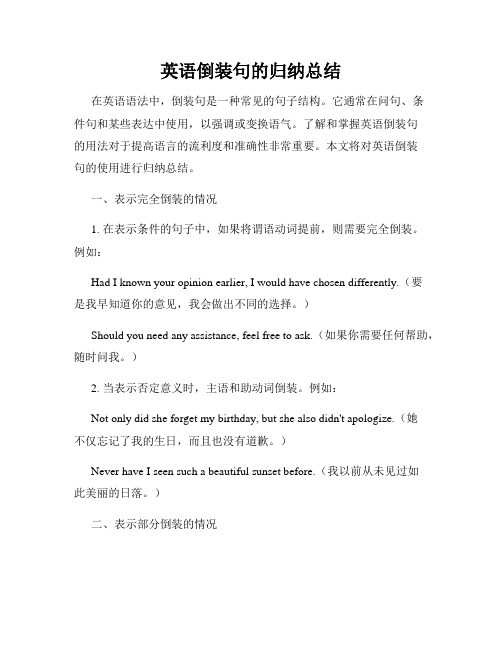
英语倒装句的归纳总结在英语语法中,倒装句是一种常见的句子结构。
它通常在问句、条件句和某些表达中使用,以强调或变换语气。
了解和掌握英语倒装句的用法对于提高语言的流利度和准确性非常重要。
本文将对英语倒装句的使用进行归纳总结。
一、表示完全倒装的情况1. 在表示条件的句子中,如果将谓语动词提前,则需要完全倒装。
例如:Had I known your opinion earlier, I would have chosen differently.(要是我早知道你的意见,我会做出不同的选择。
)Should you need any assistance, feel free to ask.(如果你需要任何帮助,随时问我。
)2. 当表示否定意义时,主语和助动词倒装。
例如:Not only did she forget my birthday, but she also didn't apologize.(她不仅忘记了我的生日,而且也没有道歉。
)Never have I seen such a beautiful sunset before.(我以前从未见过如此美丽的日落。
)二、表示部分倒装的情况1. 在使用否定副词或短语(如never, seldom, hardly, little, nowhere等)引导的句子中,形容词或副词位于句首,主语和谓语动词部分倒装。
例如:Hardly had I started my work when the phone rang.(我刚开始工作,电话就响了。
)Never before have I heard such a beautiful song.(我以前从未听过如此美妙的歌。
)2. 在以only开头的句子中,only位于句首时,主语和谓语动词部分倒装。
例如:Only by working hard can you achieve your goals.(只有通过努力工作,你才能实现目标。
- 1、下载文档前请自行甄别文档内容的完整性,平台不提供额外的编辑、内容补充、找答案等附加服务。
- 2、"仅部分预览"的文档,不可在线预览部分如存在完整性等问题,可反馈申请退款(可完整预览的文档不适用该条件!)。
- 3、如文档侵犯您的权益,请联系客服反馈,我们会尽快为您处理(人工客服工作时间:9:00-18:30)。
英语语法归纳总结及倒装句语法归纳总结一. 词类英语词类分十种:名词、形容词、代词、数词、冠词、动词、副词、介词、连词、感叹词。
1. 名词(n.):表示人、事物、地点或抽象概念的名称。
例:boy, morning, bag, home, class, orange.2. 代词(pron.):主要用来代替名词。
例:who, she, you, it .3. 形容词(adj..):表示人或事物的性质或特征。
例:good, right, white .4. 数词(num.):表示数目或事物的顺序。
例:one, two, three, first, second, third, fourth.5. 动词(v.):表示动作或状态。
例:am, is,are,have,see .6. 副词(adv.):修饰动词、形容词或其他副词,说明时间、地点、程度等。
例:now, very, here, often, quietly, slowly.7. 冠词(art..):用在名词前,帮助说明名词。
例:a, an, the.8. 介词(prep.):表示它后面的名词或代词与其他句子成分的关系。
例:in, on, from, above, behind.9. 连词(conj.):用来连接词、短语或句子。
例:and, but, before .10. 感叹词(interj..):表示喜、怒、哀、乐等感情。
例:oh, well, hi, hello.二. 句子成分英语句子成分分为七种:主语、谓语、宾语、定语、状语、表语、宾语补足语。
1. 主语是句子所要说的人或事物,回答是“谁”或者“什么”。
通常用名词或代词担任。
例:I’m Miss Green.我是格林小姐。
2. 谓语动词说明主语的动作或状态,回答“做(什么)”。
主要由动词担任。
例:Jack cleans the room every day. 杰克每天打扫房间。
3. 表语在系动词之后,说明主语的身份或特征,回答是“什么”或者“怎么样”。
通常由名词、代词或形容词担任。
例:My name is Ping ping. 我的名字叫萍萍。
4. 宾语表示及物动词的对象或结果,回答做的是“什么”。
通常由名词或代词担任。
例:He can spell the word. 他能拼这个词。
有些及物动词带有两个宾语,一个指物,一个指人。
指物的叫直接宾语,指人的叫间接宾语。
间接宾语一般放在直接宾语的前面。
例:He wrote me a letter. 他给我写了一封信。
有时可把介词to或for加在间接宾语前构成短语,放在直接宾语后面,来强调间接宾语。
例:He wrote a letter to me. 他给我写了一封信。
5. 定语修饰名词或代词,通常由形容词、代词、数词等担任。
例:Shanghai is a big city. 上海是个大城市。
6. 状语用来修饰动词、形容词、副词,通常由副词担任。
例:He works hard. 他工作努力。
7. 宾语补足语用来说明宾语怎么样或干什么,通常由形容词或动词充当。
例:They usually keep their classroom clean. 他们通常让教室保持清洁。
The teacher wanted me to learn French all by myself. 老师要我自学法语。
注意:同位语通常紧跟在名词、代词后面,进一步说明它的情况。
例:Where is your classmate Tom ? 你的同学汤姆在哪里?三. 英语中的五种基本句型1. 基本句型一:SV(主+谓)谓语通常是不及物动词。
例:The moon rose. 月亮升起了。
What he said does not matter. 他所讲的没有什么关系。
2. 基本句型二:SVP(主+谓+表)此句型的句子有一个共同的特点:句子谓语动词都不能表达一个完整的意思,必须加上一个表明主语身份或状态的表语构成复合谓语,才能表达完整的意思。
这类动词叫做连系动词。
系动词分两类:be, look, keep, seem等属一类,表示情况;get, grow, become, turn, stay, remain等属另一类,表示变化。
另外感官动词如sound, smell, listen, taste等用法同be动词。
be 本身没有什么意义,只起连系主语和表语的作用。
其它系动词仍保持其部分词义。
例:This is an English-Chinese dictionary. 这是本英汉辞典。
The dinner smells good. 晚餐的气味很好。
3. 基本句型三:SVO(主+谓+宾)此句型句子的共同特点是:谓语动词都具有实义,都是主语产生的动作,但不能表达完整的意思,必须跟有一个宾语,即动作的承受者,才能使意思完整。
这类动词叫做及物动词。
例:He has refused to help them. 他拒绝帮他们的忙。
They ate what was left over. 他们吃了剩饭。
4. 基本句型四:SVO间O直(主+谓+间宾+直宾)此句型的句子有一个共同特点:谓语动词必须跟有两个宾语才能表达完整的意思。
这两个宾语一个是动作的直接承受者,另一个是动作的间接承受者。
通常这一间接承受者用一个介词来连接,当动作的间接承受者在动作的直接承受者之前时,这一介词往往被省略。
例:He brought you a dictionary. 他给你买了一本字典。
I told him that the bus was late. 我告诉他汽车晚点了。
5.基本句型五:SVOC(主+谓+宾+宾补)此句型的句子的共同特点是:动词虽然是及物动词,但是只跟一个宾语还不能表达完整的意思,必须加上一个补充成分来补足宾语,才能使意思完整。
例:They painted the door green. 他们把门漆成绿色。
I saw them getting on the bus. 我看见他们上了那辆公共汽车。
但常用的英语句子并不都像基本句型这样简短,这些句子除了基本句型的成分不变外,通常是在这些成分的前面或后面增加一些修饰语而加以扩大。
这些修饰语可以是单词(主要是形容词、副词和数词),也可以是各种类型的短语(主要是介词短语、不定式短语和分词短语)。
下面以基本句型五为例:We found the hall full. 我们发现礼堂坐满了。
We found the great hall full of students and teachers. 我们发现大礼堂坐满了学生和教师。
We found the great hall full of students and teachers listening to an important report.我们发现大礼堂坐满了学生和教师,在听一个重要报告。
We found the great hall full of students and teachers listening to an important report made by a comrade fromthe People's Daily on current affairs in East Europe.我们发现大礼堂坐满了学生和教师,在听人民日报的一位同志作有关东欧局势的重要报告。
倒装句英语句子的自然语序是主语在前,谓语动词在后。
如果把谓语动词放在主语之前,就称为倒装结构;如果谓语全部放在主语之前,就称为完全倒装;如果只把助动词、be动词或情态动词放在主语之前,就称为部分倒装。
完全倒装1. 以here, there, now, then开头,谓语动词是be, come, go, follow 等词,主语为名词。
例:Now comes your turn to answer the questions.2. 以up, down, out, in, away, off 等表示移动方向的副词开头的句子, 谓语通常为go, come, rush, fly, fall 等不及物动词,主语为名词。
例:Out rushed the boy.【注意】以上两种句型中,若主语是代词,即使here, there, now, then, up, down, out, in, away, off 等放在句首,也不用倒装。
例:Out he rushed. Here you are!3. 表示地点的介词短语或副词(短语如on the wall, under the tree, in front of the house, in the middle of theroom等) 位于句首,谓语是不及物动词,主语是名词。
例:Between the two buildings stands a tall tree.East of the city lies a big river.4. 表语位于句首,构成“形容词/ 现在分词/ 过去分词+连系动词+主语” 结构。
例:Present at the meeting were Professor Smith and many other guests.5. 代词such作表语,位于句首时。
例:Such are the facts: no one can deny (拒绝) them.6. 保持句子平衡或使上下文衔接更紧密时。
例:Inside the pyramids (金字塔) are the rooms for the kings and queens and long passages to these rooms.例题赏析:— Is everyone here?— Not yet. Look , there _______ the rest of our guests!A. comeB. comesC. is comingD. are coming【解析】谓语动词根据后面的主语可知是完全倒装,因此选择A。
完全倒装练习1. ________ a beautiful palace ________ the foot of the hill.A. There stand; atB. There stands; underC. Stands there; underD. There stands; at2. ________ from the top of the building when the policeman pointed the gun at him.A. Jumped down the robberB. Jumped the robber downC. Down jumped the robberD. Down the robber jumped3. ________ are the days when teachers were looked down upon.A. GoneB. GoC. To goD. Going4. At the meeting place of the Yangtze River and the Jialing River________, one of the ten largest cities in China.A. lies ChongqingB. Chongqing liesC. does lie ChongqingD. does Chongqing lie5. For a moment nothing happened, then ________ all shouting together.A. voices had comeB. came voicesC. voices would comeD. did voices come部分倒装1. only修饰副词、介词短语或状语从句,且放在句首时。
